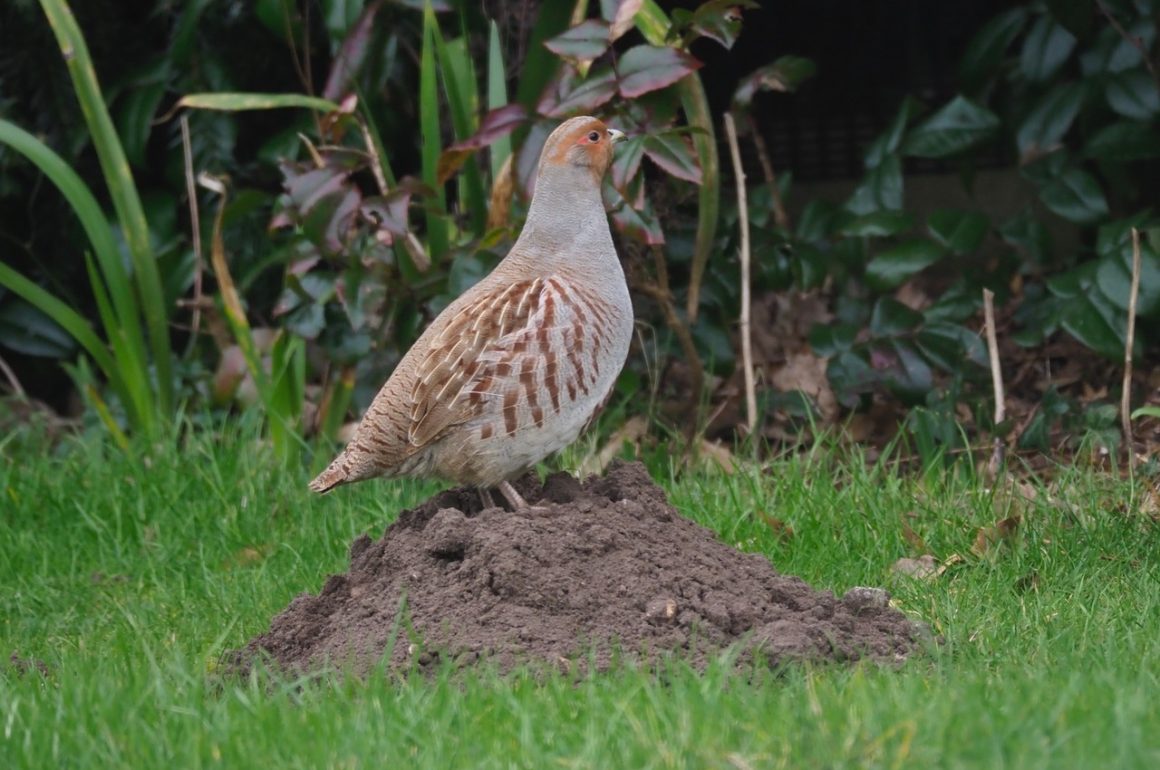
Last week I wrote about the birds that fly over my Suffolk garden (in eastern England), this time it’s the turn of the real garden birds, those that not only land in the garden, but also feed in it. I’ve only lived in my current house for five years: the previous owners weren’t interested in either birds or gardening, so I have to work hard to make the half-acre property more attractive to birds. I’ve planted a native hedge with elder, hawthorn, yew and wild roses, created a small orchard and dug a pond. In addition I provide plenty of feeders, stocked with mixed seed and husked sunflowers, plus fat balls. I used to offer both peanuts and niger seed, but intriguingly the birds no longer seem interested in either.
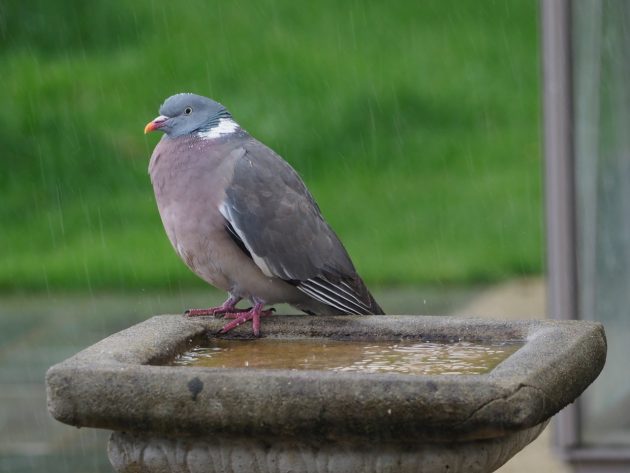
A Woodpigeon contemplates a bath on a wet day
Most conspicuous of the every-day birds are the Woodpigeons (above). Not a day goes by without woodies in the garden for this is one of the most abundant of local birds. Curiously, though these pigeons are numerous on the local farmland, my observations suggest that my garden birds rarely venture far into the surrounding countryside. They clearly know where they are well off.
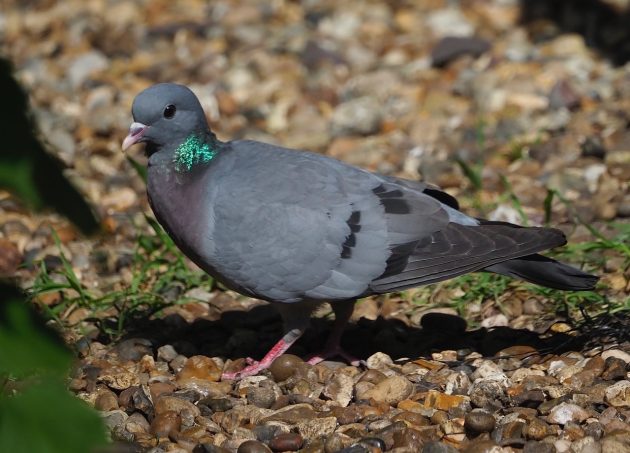
Stock Doves rarely land in the garden. This bird did so on 21 June this year
Collared Doves are also daily visitors, though not quite so frequent as their larger cousins. These doves are relatively recent colonists, as the first pair recorded nesting in the county in 1959. Though Stock Doves can often be seen flying over, they rarely land in the garden. They do occasionally: my photograph was taken in the garden this year, on 21 June.
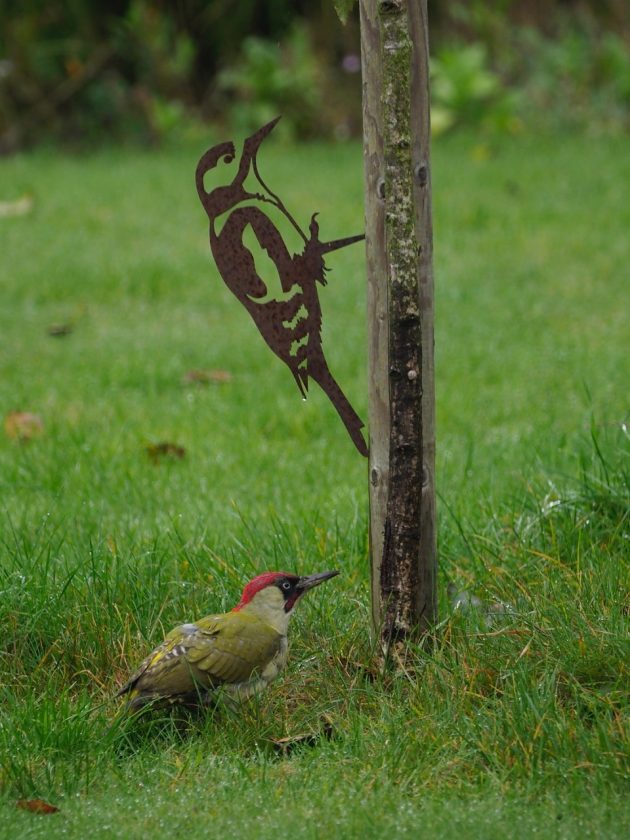
This Green Woodpecker ignored the metal Great Spotted Woodpecker
It’s always a treat when a Green Woodpecker arrives in the garden: they usually spend time hoping around on the lawn, feasting on ants. Great Spotted Woodpeckers are only occasional visitors, which is surprising as these handsome birds are readily attracted to bird tables. At my last garden they were daily visitors.
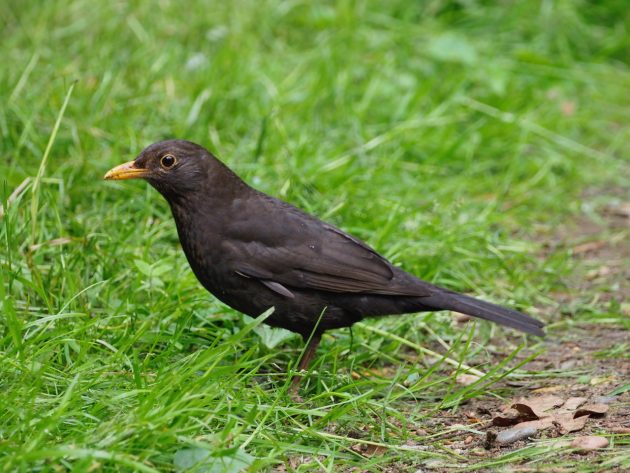
Blackbirds (above) are conspicuous residents and can be seen all year, though there are times in the autumn when they become less obvious. One of my favourite indications of the changing year is when I hear a cock blackbird uttering his first tentative notes of song at dusk on a mild February day. It’s the young birds that sing first, with the older males not joining in until March. I can then look forward to hearing these melodious songsters every day until mid July.
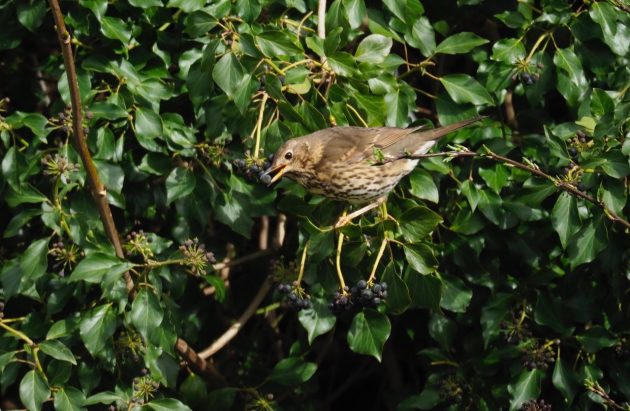
Song Thrushes are fond of ivy berries growing in my hedge
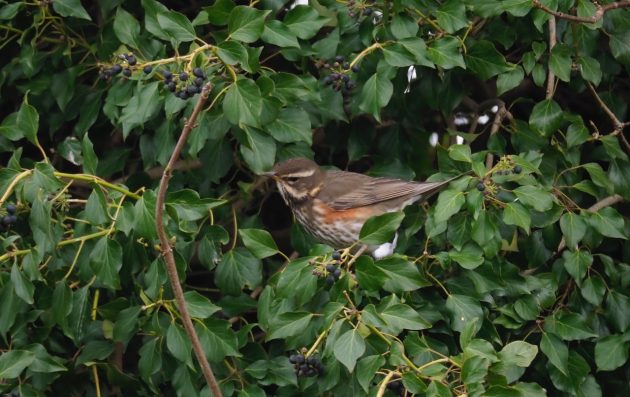
A Redwing feeding on ivy berries in March
While Mistle Thrushes fly over regularly, they rarely land. Song Thrushes appear much more frequently, and from late winter there’s usually one singing at dawn and dusk. These thrushes were once much more common that they are today, so I’m always delighted when I either see or hear one. It takes cold weather to push Redwings into the garden. These migratory thrushes are shy birds, but they are attracted to the ivy berries in my hedge. Fieldfares, the Redwing’s larger cousin, also come into the garden occasionally, but are more often seen flying over. I took the photograph (below) on 24 January 2023, my birthday.
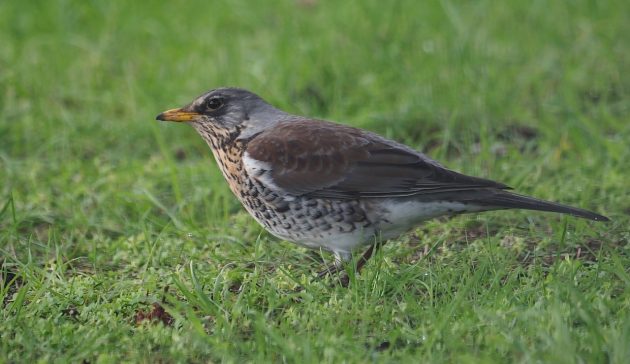
Robins are familiar year-round residents, and one that occasionally nests in the garden – I provide a couple of suitable open-fronted nest boxes. Wrens also occur throughout the year, but they are independent birds, not interested in my feeders. This is in contrast to the Dunnocks (below), though they come low in the pecking order, so generally scavenge for crumbs under the feeders. They have a pretty and rather under-rated song that can be heard from early spring right through to the end of the breeding season. It’s always a delight to find a Dunnock’s nest, for they lay the most beautiful sky-blue eggs, smooth and glossy with no markings.
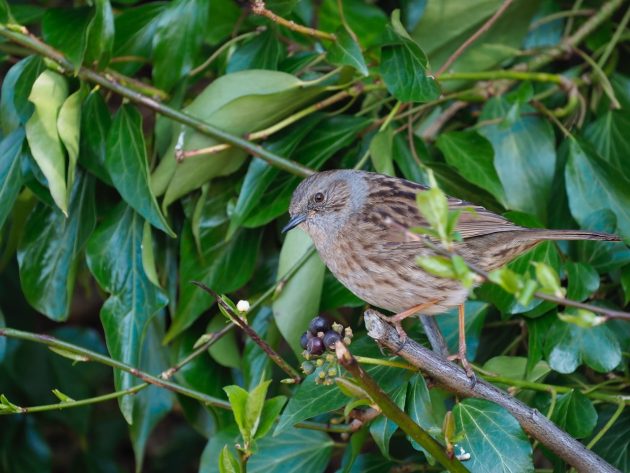
Dunnock: a common but unobtrusive resident
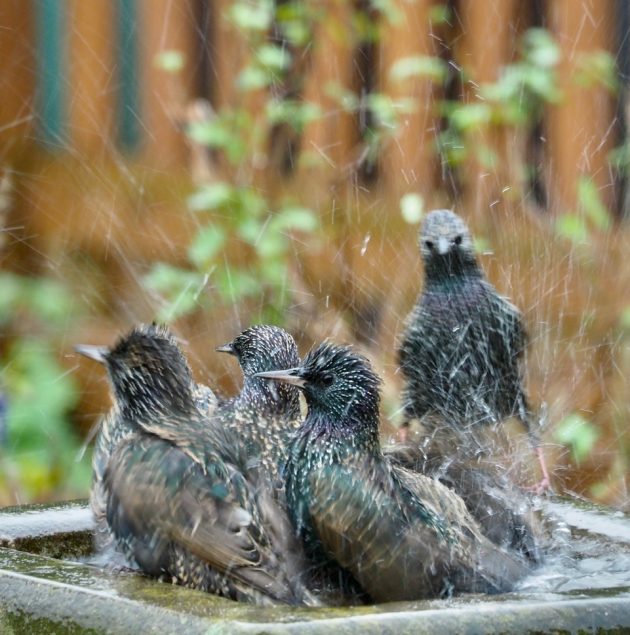
Starlings enjoying a communal bath on a December day
Starlings are periodic visitors. In the spring they are daily visitors, raiding my feeders for fat to feed to their growing youngsters. In late May, when the young birds leave the nest, there can be as many as 40 or 50 in the garden at once. Starlings are very good at synchronising their hatching, so all the birds in the area fledge within a few days of each other. This, no doubt, helps overall survival. They are very dapper birds and clearly like to look smart, for they bathe frequently, often in company. The photograph above was taken from my study window on 29 December 2021.
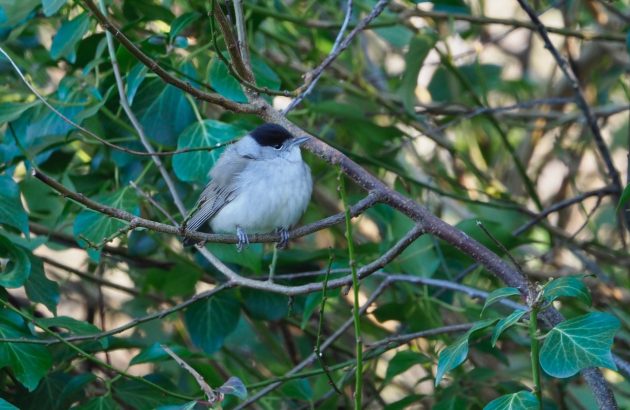
A wintering Blackcap, photographed in December 2023
There’s a tall, thick hedge bordering the eastern side of the garden, and every spring this holds a singing Blackcap. These warblers have a subtle but attractive song which is always a delight to listen to. Blackcaps are mostly summer visitor to this part of England, but increasing numbers of individuals now over-winter. Last winter I saw a male Blackcap on several occasions in December, but only once in January. Ringing records show that our nesting Blackcaps go south in the winter to the Mediterranean, while the wintering birds come from Germany and eastern Europe.
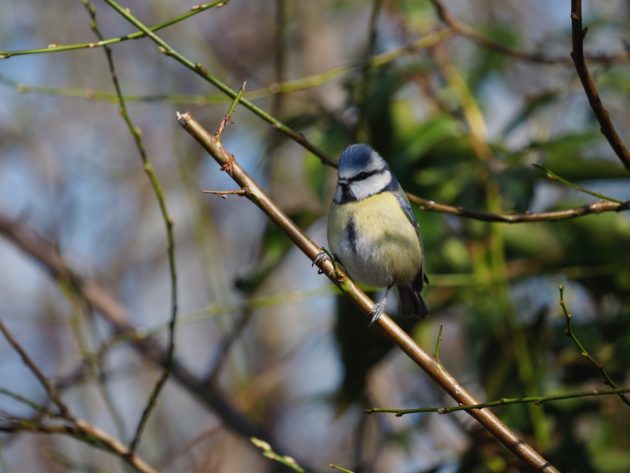
A Blue Tit in early spring
Four species of tits are regular visitors – Great, Blue (above), Coal and Long-tailed. The latter always appear in roving flocks, and never stay for long, but in passing they will cluster onto one of the feeders, with as many as nine or ten birds competing for a perch. Goldcrests (below), the smallest of my garden birds, are periodic visitors: they can often be heard singing in late winter and early spring, but spotting the singer can be a challenge.
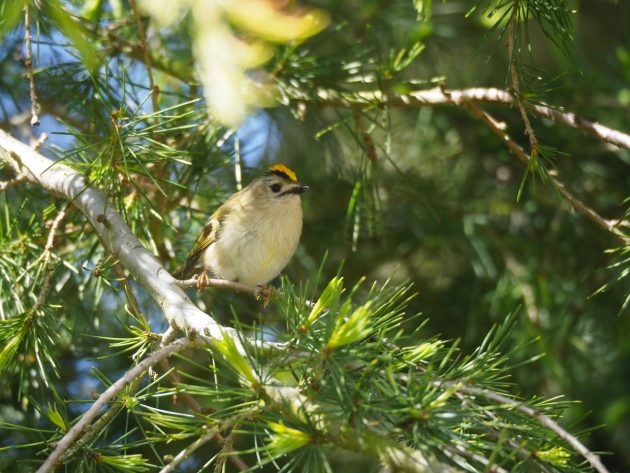
The smallest of my garden visitors: a Goldcrest
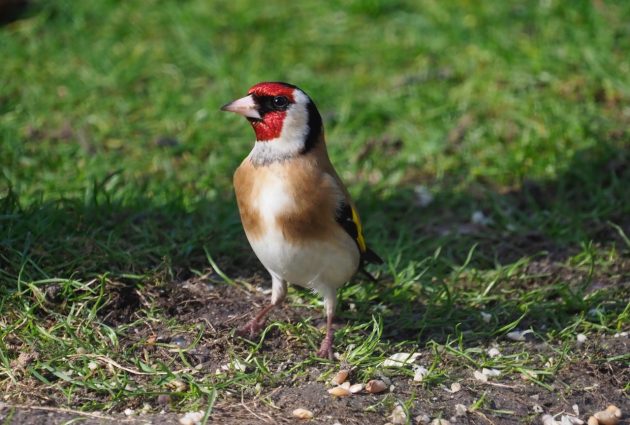
Goldfinches add a touch of colour throughout the year
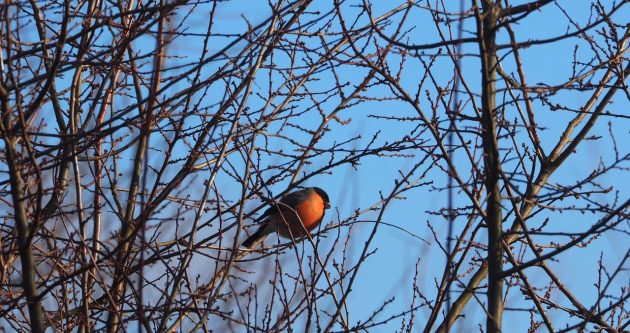
A lost garden bird? No Bullfinches have been seen for three years: I am still hoping to improve on this picture, taken soon after moving to my current house
While Greenfinches are daily visitors in varying numbers throughout the year, Chaffinches have become quite scarce. In my first winter here I was delighted to see Bullfinches on a number of occasions. The photograph (above) was taken on 6 January 2020, a month after I had moved here. The following winter I had one sighting, but none since. Hopefully they might re-appear one day. Goldfinches occur throughout the year, while Siskins are daily winter visitors to gardens just a short flight away, but they are rare birds here, though I expect to see a few each winter. So far I’ve only recorded a Brambling once, a cock (below) on 21 April 2021. He must have been heading back to Scandinavia.
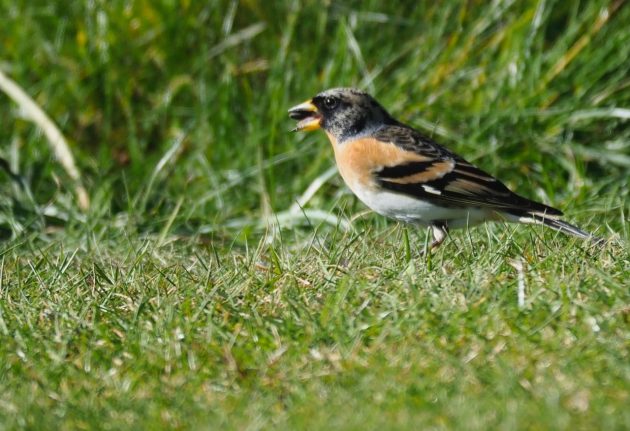
This cock Brambling paused in the garden briefly one April
Among my favourite regular visitors are Reed Buntings (below). They invariably appear in late winter and through into the spring – my earliest dates are at the start of February, the latest at the end of April. My maximum count is six, but it’s more often one or two, and almost always cocks. They are attracted by the feeders filled with husked sunflowers.
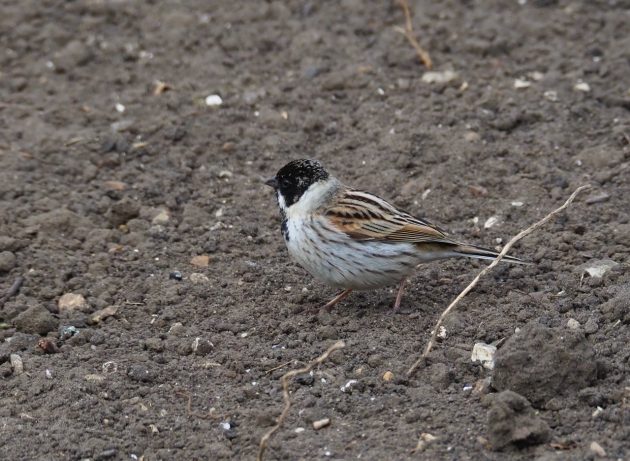
A February Reed Bunting feeding in one of my raised beds
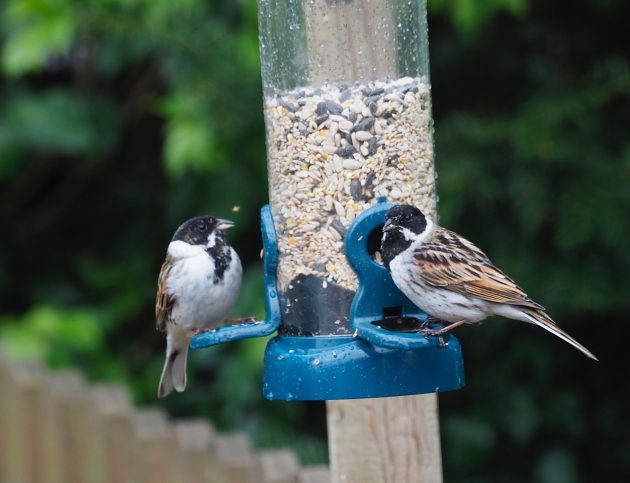
Two cock Reed Buntings photographed at the end of April
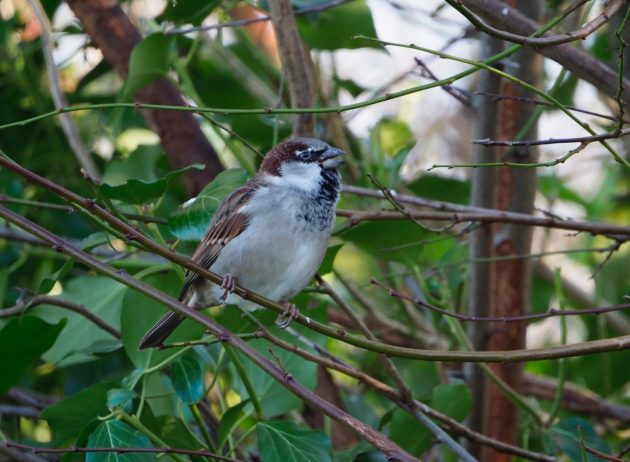
A cock House Sparrow
House Sparrows (above) deserve a mention, for at my last house these were rarities, but here, living in a village, they are much more frequent visitors. They usually come to feed in small flocks, usually no more than a dozen birds, but in winter there might be 30 or more. My maximum count is 49 – I couldn’t find a 50th.
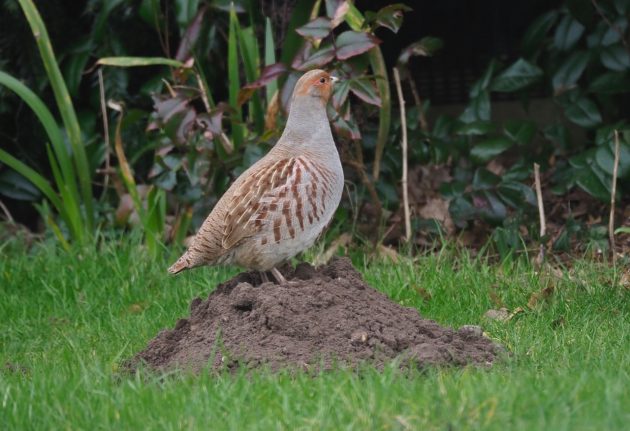
A cock Grey Partridge on a mole hill in my orchard. The mole is an unwelcome visitor
One of my best garden records is a Quail, heard from the kitchen, but calling from a barley field just over my hedge. I regularly see Grey Partridges on the fields beyond the garden, and occasionally they venture into the garden. The splendid cock (above) was another bird photographed from my study window, this time on a dull January day.
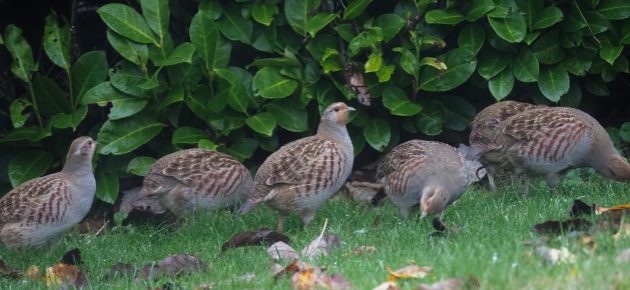
On another occasion a covey of six spent some time foraging in the garden (above). Pheasants are common locally, but only occasionally come into the garden. The bird in my photograph (below) was a regular visitor for several weeks earlier this year. Curiously, I’ve never seen a hen Pheasant in the garden.
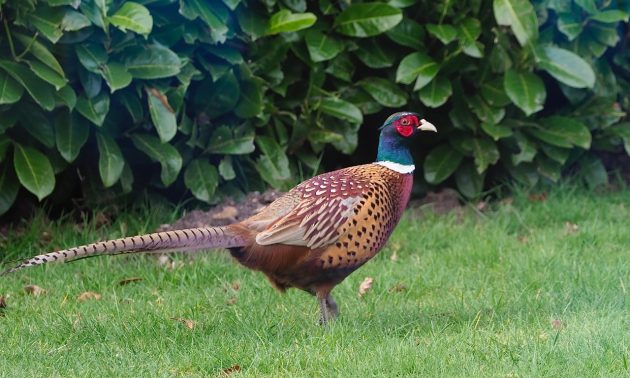
Garden birding is fun, as you never know what might turn up. I record my birds for the British Trust for Ornithology’s Garden BirdWatch, a long-running study with several thousand participants submitting weekly counts of the birds they record. It’s a classic example of citizen science, as the data it produces allows the BTO to monitor how our garden birds are faring.
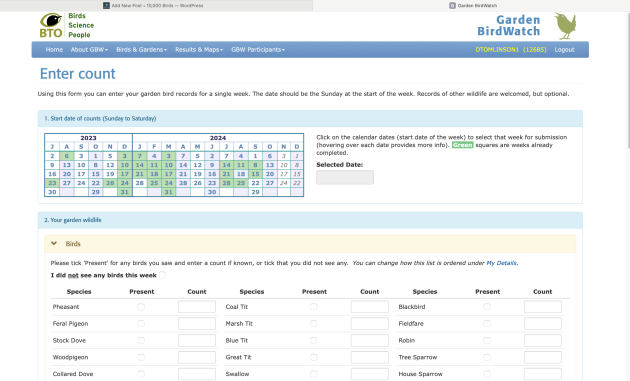
(Photographer’s note: all the photographs illustrating this piece were taken in my garden. Most were taken through double-glazed windows, which does detract from their quality.)













Reed bunting as a garden bird is quite special. Lovely post full if familiar faces. Partridge in the pear tree ?
The partridge was photographed just a few feet from a pear tree, but it didn’t show any sign of wanting to perch in it. Shame, as that would have made a fine photograph.